#elearning solution
Text
LMS Monks: Your Gateway to Modern Online Learning
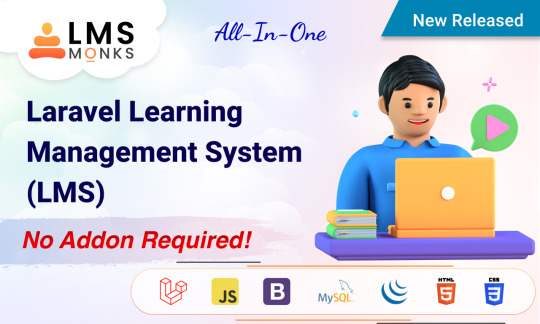
LMS Monks is a state-of-the-art learning management system (LMS) software that brings a revolution to online education. Designed to cater to the ever-evolving world of e-learning, LMS Monks is the go-to solution for creating and selling online courses.
LMS Monks ensures a seamless experience for online academies. Whether you're a healthcare institution, a company, an academy, a school, a coaching center, a celebrity, a professor, a photographer, or a chef, LMS Monks has a specialized version to suit your needs.
LMS Monks offers a wide range of features and applications to enhance the learning process. With our platform, you can conduct live classes, administer exams, and enjoy a coaching experience like no other.
Recognized for our exceptional service delivery, LMS Monks has earned a well-deserved spot among the top LMS software providers. Trusted by over 200 online academies, we take pride in being a reliable and dependable partner for your e-learning journey.
Our platform boasts over 100 features that cater to the needs of administrators, marketers, security-conscious users, and data analysts. Whether you're managing your courses, promoting your content, ensuring a secure environment, or analyzing learner data, LMS Monks has got you covered.
We bring together the best features of popular platforms like Moodle and Google Classroom, all under one branded option. This means you get the versatility and functionality you need, with the added benefit of a personalized touch.
Join the league of forward-thinking educational institutions and experience the future of online learning with LMS Monks. Our trusted and acclaimed LMS software ensures a seamless and engaging educational experience for learners worldwide.
#eOnline#edtech#education#elearning#educators#online learning#Laravel LMS#Laravel Learning Management System#eLearning Solution#eLearning Platform
2 notes
·
View notes
Text
Learn: How Smartphone Apps Are Changing the Game!
Are you looking for CBSE Syllabus, Then Subscribe to Digital Teacher Canvas Online learning classes for just 1949 rupees only.
#smart classroom#digital classroom#digi class#online learning app#elearning#study online#learning application#online classroom#digital learning#learning app#online learning platform#online education#digital education#online classes#digital class software#digital class solution#online learning#software#technology
3 notes
·
View notes
Text
9 Reasons Why Online Learning Solutions Are the Future of Education
Education is at a crossroads. The traditional, one-size-fits-all classroom model struggles to keep pace with the rapidly evolving needs of learners and demands of the modern world. Enter online learning solutions, a dynamic and adaptable approach poised to revolutionize the educational landscape. Here are 9 reasons why online learning is destined to shape the future of education:

1. Increased Accessibility and Flexibility:
Gone are the days of geographical or time constraints dictating access to quality education. Online learning solutions break down barriers, offering courses anytime, anywhere, on any device. Students can learn at their own pace, balancing studies with work, family, or other commitments. This flexibility empowers individuals from diverse backgrounds and circumstances to pursue their educational goals.
2. Personalized Learning Experiences:
No two learners are alike. Online platforms leverage technology to cater to individual needs and learning styles. Adaptive learning systems adjust content and difficulty levels based on individual progress, ensuring students are challenged without feeling overwhelmed. Custom eLearning solutions allow educators to curate personalized learning paths, catering to specific interests and goals.
3. Interactive and Engaging Content:
Learning shouldn’t be a passive experience. Online solutions offer a treasure trove of interactive resources: multimedia lectures, gamified learning modules, simulations, and collaborative activities. This engaging content grabs attention, fosters active participation, and solidifies understanding beyond traditional textbooks and lectures.
4. Cost-Effectiveness and Scalability:
Education can be expensive. Online learning offers a cost-effective alternative, reducing infrastructure and material costs. Educational institutions can reach wider audiences without geographical limitations, maximizing impact with less expense. This scalability allows for broader access to quality education, creating a more equitable learning environment.
5. Global Collaboration and Cultural Exchange:
The virtual classroom breaks down geographical barriers, connecting students and educators from across the globe. This fosters collaboration and cultural exchange, preparing learners for a world increasingly interconnected and diverse. Imagine collaborating on a project with peers from different countries or learning about global perspectives from international instructors – online learning makes it possible.
6. Continuous Improvement and Data-Driven Insights:
Online learning platforms generate a wealth of data about student progress, engagement, and learning styles. This data empowers educators to track individual performance, identify areas of improvement, and tailor instruction accordingly. Continuous improvement cycles optimize learning journeys, ensuring students receive the most effective support and resources.
7. Development of Essential 21st Century Skills:
The future demands critical thinkers, collaborators, and problem-solvers. Online learning inherently fosters these skills. Collaborative projects, online discussions, and self-directed learning encourage critical thinking, communication, and independent learning – all essential for success in the modern world.
8. Lifelong Learning Opportunities:
The world of knowledge is constantly evolving. Online learning platforms provide a gateway to lifelong learning opportunities. Professionals can upskill, individuals can explore new interests, and anyone can access ongoing education beyond traditional degrees or diplomas. This democratizes knowledge and empowers individuals to continuously adapt and thrive in a dynamic world.
9. A Sustainable and Environmentally Friendly Choice:
Online learning reduces dependence on physical infrastructure like classrooms and printed materials. This minimizes environmental impact by lowering energy consumption and paper waste. As we strive for a sustainable future, online learning offers an environmentally conscious approach to education.
The Future is Now:
While online learning solutions cannot entirely replace traditional classrooms, they offer a powerful and adaptable tool for enriching the educational landscape. By harnessing the potential of online learning, we can create a more accessible, personalized, and engaging learning experience for all, paving the way for a brighter and more empowered future.
Content Source https://explainlearning.com/blog/9-reasons-why-online-learning-solutions-are-the-future-of-education/
#Online Learning Solutions#Learning Solutions#education#usa#explain learning#e learning#elearning#learning#united states
2 notes
·
View notes
Text
IETM for Beginners A Quick Guide to IETM Code and Pixels
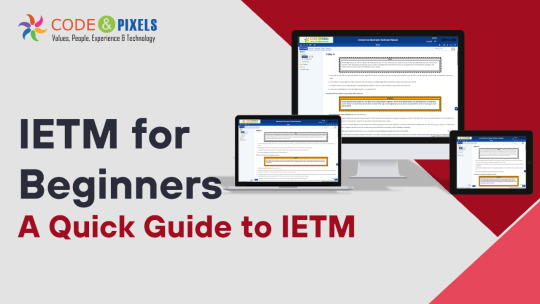
IETM: Interactive Electronic Technical Manual
Training Aids to Defence Client
If you are a supplier of defence then along with the system/equipment you also need to provide Training Aids
(CBT) — Computer-Based Training
Charts and Bloups
Video Film
Training Work Modules
Manuals Hard Copies
IETM
Evolution of Documentation in Defence
Before — Hardcopies and PDFs in DVDs (Upto 2015)
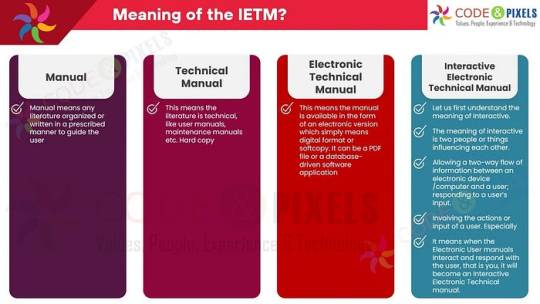
What is the meaning of the IETM?
Manual: Manual means any literature organized or written in a prescribed manner to guide the user.
TechnicalManual: This means the literature is technical, like user manuals, maintenance manuals etc. Hard copy
Electronic Technical Manual: This means the manual is available in the form of an electronic version which simply means digital format or softcopy. It can be a PDF file or a database-driven software application.
Interactive Electronic Technical Manual:
Let us first understand the meaning of Interactive.
The meaning of interactive is two people or things influencing each other.
Allowing a two-way flow of information between an electronic device /computer and a user; responding to a user’s input.
Involving the actions or input of a user. Especially
It means when the Electronic User manuals Interact and respond with the user, that is you, it will become an Interactive Electronic Technical manual.
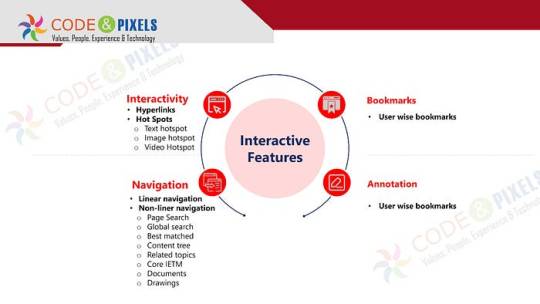
Interactive Features
Interactivity
Hyperlinks
Hot Spots
Text hotspot
Image hotspot
VideHotspot
Bookmarks
User wise bookmarks
Navigation
Linear navigation
Non-liner navigation
Page Search
Global search
Best matched
Content tree
Related topics
Core IETM
Documents
Drawings
Annotation
User wise bookmarks
The documents and pages are many hence, for easy and fast accessibility complete content is converted and stored as a database.
Whenever the user wants some information, IETM software produces the information in a fraction of a second.
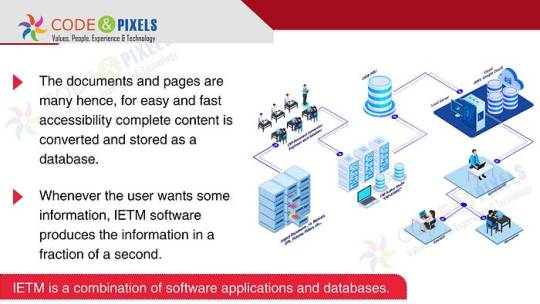
Use or Purpose of the IETM?
The purpose of the Manual is to give information related to the equipment to the end user for quick reference.
All the technicality is written in detail so that when an issue arises, the user can refer to the manual, as every time OEM or technical person or subject matter expert might not be available on the spot to resolve the issue.
If the manual has 10 pages users can refer easily.
But any system used by the defence will have multiple manuals and thousands of page counts and many times a user has to cross-refer between manuals, intra-manual and inter-manual to resolve the issue.
Referring to 10- 15 hard-copy or even soft-copy books simultaneously will be difficult and time-consuming.
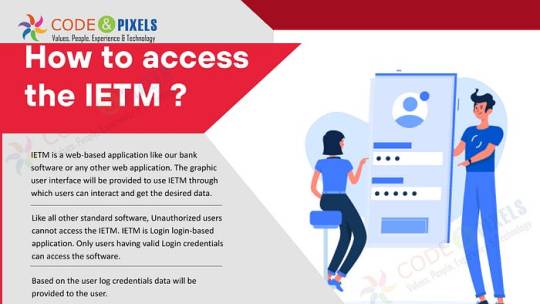
How to access the IETM ?
IETM is a web-based application like our bank software or any other web application. The graphic user interface will be provided to use IETM through which users can interact and get the desired data.
Like all other standard software, Unauthorized users cannot access the IETM. IETM is a Login - login-based application. Only users having valid Login credentials can access the software.
Based on the user log credentials data will be provided to the user.
IETM has 2 types of Users and one Administrator
Maintainer
Operator
If the operator logs in, the user gets all the content related to operator use, similarly if the maintainer logs in only maintenance-related content is visible for that user.
Ideally, all the content is available for both users, because the purpose of the IETM is to refer to the manual to fix the issue.
Administrators can create users who can see the user’s navigation and log-in history and interact with the users using user dashboards through Annotations.
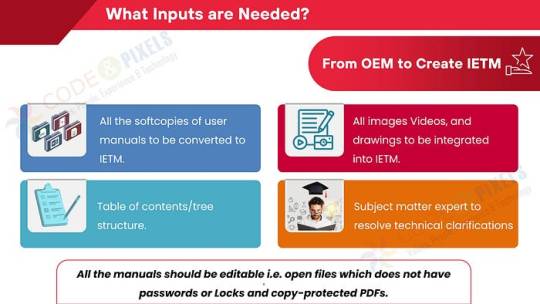
What Inputs are Needed? (From OEM to Create IETM)
All the softcopies of user manuals to be converted to IETM.
All images Videos, and drawings to be integrated into IETM.
Subject matter expert to resolve technical clarifications
Table of contents/tree structure.

Minimum Hardware Requirements?
NO High-end hardware or servers are required to run IETM.
However, if more concurrent users, then a good configuration server with good LAN connectivity must be ensured.
i3 with 8 GB RAM systems is the minimum configuration required for the server or for Node.
Deliverables
BASED DB (Manuals are covered in the Database)
IETM VIEWER Software
User Manual and Installation Manual
Standards — compliance
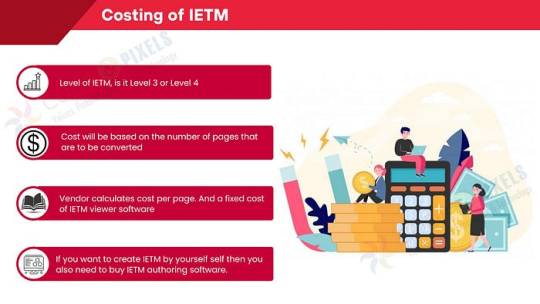
Costing of IETM: (Interactive Electronic Technical Manual)
Level of IETM, is it Level 3 or Level 4
Cost will be based on the number of pages that are to be converted
The vendor calculates the cost per page. And a fixed cost of IETM viewer software
If you want to create IETM by yourself self then you also need to buy IETM authoring software.
What are these Levels?
Level — 1 is any PDF file
Level — 2 is a PDF file with hyperlinks from the table of contents to the body etc.
Level — 3 is an HTML application. More hyperlinks, simple search, a content tree having log a screen with a hardcoded username and password and supplied in the format of EXE so that Windows can easily open
Level — 4 is Software plus Content/manuals converted as Database
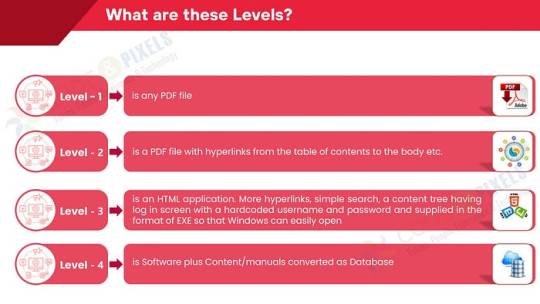
Regarding Level — 5, rest assured, till 2028 it will be Level — 4 only. As of now, there is nothing practically called Level — 5. Few are calling virtual reality and Augmented reality and Artificial intelligence Level — 5.
Pulling data from many user inputs and analyzing and giving results are done in Level — 5. IETM software cannot pull the data from various real-time points as No OEM will give the real-time information to third-party software directly. Yes, if the information is available offline, then that information can be imported into IETM and can be used as a reference.

#ietm#software#technology#ietm developement#ietm code and pixels ietm hyderabad#ietm software#elearning#code and pixels#ietm level iv#codeandpixels#ietm level 4 software requirements#technical documentation#ietm document#ietm documentation#interactive electronic technical manual#Ietm Service Providers#Ietm Software Designers of India#Software Development Company#Elearning Solutions Company#E Learning Content Development Company#Online Education#Digital Education#Digital Content#Software Development Solutions#Elearning#Ietm Developers#Econtent Development#Elearning Solutions Providers#Econtent Developers#Econtent
2 notes
·
View notes
Text
CBSE Schools Digital Teacher
Central Board Of Secondary Education, commonly known as CBSE is constituted in the year of 1952. However, in the year of 1962 the board extended its wings, which not only have PAN India presence, but also spread across various continents.
https://www.digitalteacher.in/blog/cbse-schools-digital-teacher/
#smart classroom#digital classroom#digi class#online learning app#elearning#study online#learning application#online classroom#digital learning#learning app#online learning platform#online education#digital education#online classes#digital class software#digital class solution#online learning#software#technology#education#education technology#smart class#digital teacher#smart class solution#smart classroom software#elearning software#digital teacher#digital teacher canvas
2 notes
·
View notes
Text
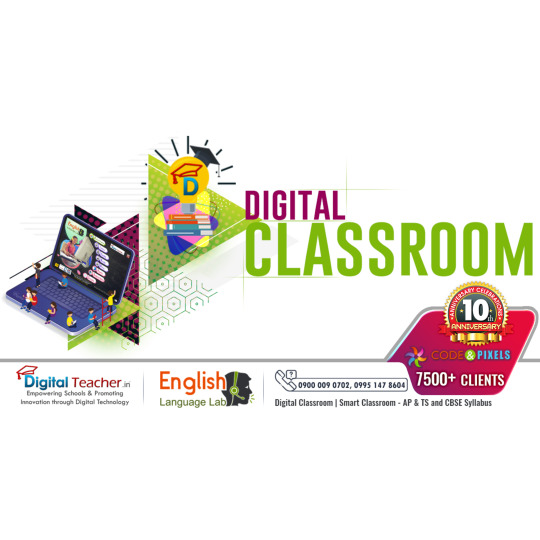
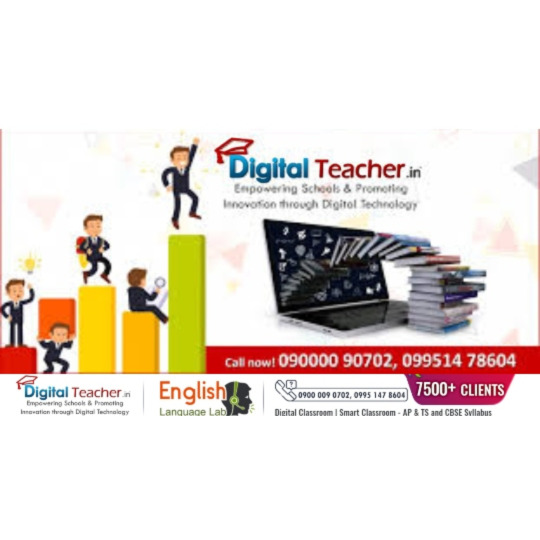
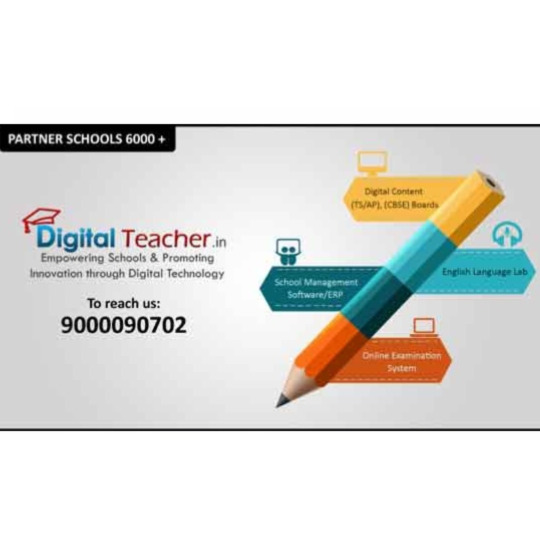
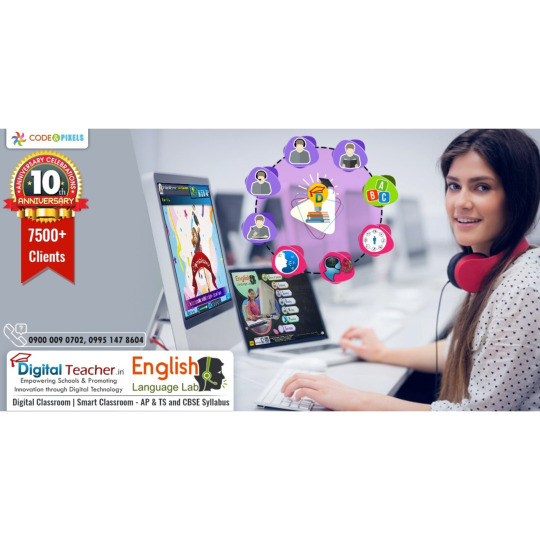
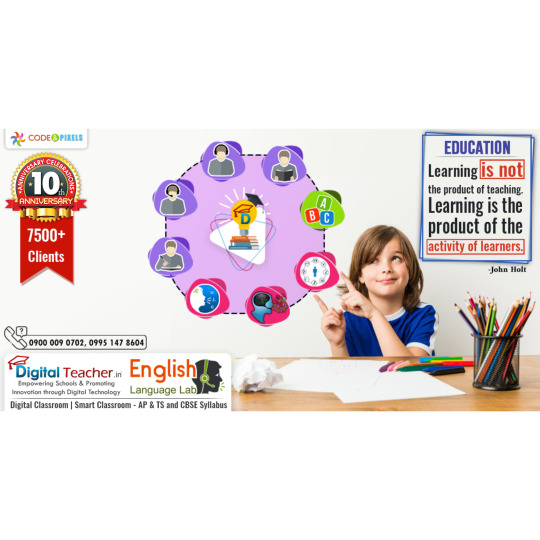




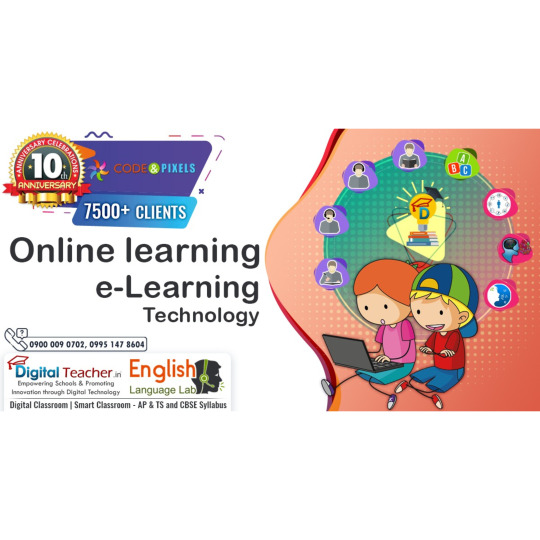

Digital class boards integrated with digital classroom software help to expand the nature of the content with support of illustrations, graphs and animation
#digi class#digital class#digital class board#digital classroom#digital classrooms#making notes#Online resources#Online videos#computer based teaching#digital classroom software#code and pixels#digital content#digital india#digital solutions#digital teacher#elearning solution providers#english lab#english language lab#language lab#simulation based learning#smart classroom#smart classroom solution#smart classrooms#smart class#the learning app#elearning app#digital teacher app#digital teacher learning app#digital teaching tools#elearning solutions
2 notes
·
View notes
Text
Custom eLearning Solutions for Effective Learning and Development
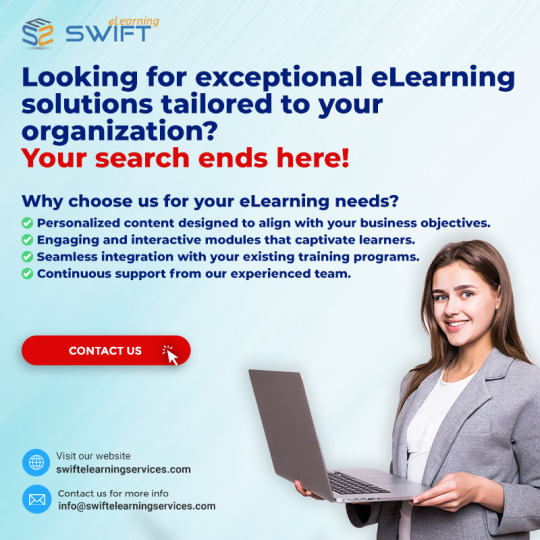
Custom eLearning solutions design interactive, engaging courses tailored to meet your specific training needs at competitive prices.
Our eLearning Solutions:
Rapid eLearning
Blended Learning
Legacy Content Conversion
Translation & Localization
Learning Management System (LMS)
Human Resource Management System (HRMS)
What is Custom eLearning?
Custom eLearning provides personalized online courses that cater to the unique needs of learners and organizations. Our goal is to enhance training effectiveness and maximize return on investment (ROI).
The transition from ILT/VILT to eLearning: Convert classroom-based training into SCORM and HTML5 content for interactive, accessible learning.
Microlearning Solutions: Bite-sized modules designed for on-the-go learning to improve quick knowledge retention.
Game-Based Learning Solutions: Engage learners through interactive, game-based learning strategies for effective knowledge transfer.
eLearning Content Development
We offer tailored learning experiences designed to meet specific objectives and learner needs.
Rapid eLearning: Quick, efficient course development using rapid authoring tools.
Blended Learning: Seamlessly integrates in-person and online learning for a balanced training approach.
Custom eLearning Samples
Explore our diverse range of custom eLearning solutions that enhance employee skills through interactive modules and simulations.
Content Conversion Solutions
Legacy Content Conversion: Modernize outdated materials into digital formats.
Flash to HTML5: Upgrade Flash-based courses for compatibility with modern standards.
PPT to eLearning: Turn PowerPoint presentations into engaging eLearning content.
ILT to eLearning Conversion: Transform traditional training materials into dynamic eLearning courses.
Translation & Localization Solutions
Our translation services convert eLearning content into various languages, while localization adapts it to fit specific cultural contexts.
eLearning Translation Services: Convert text, images, audio, and video for multilingual learners.
Multimedia Localization: Adapt multimedia elements like graphics, animations, and more for different audiences.
Our Approach
Storyboarding: Visualizing the course structure for better clarity.
Multimedia-Rich Content: Enhance engagement with videos, animations, and infographics.
Personalization: Tailored learning experiences to match individual needs.
Scenario-Based & Gamified Learning: Real-life challenges and gamification drive deeper understanding and motivation.
Compliances and Standards
We ensure compatibility with eLearning standards such as SCORM, xAPI, and HTML5, as well as mobile responsiveness across devices. We also utilize cutting-edge technologies like AI, VR, and AR to enhance learner engagement.
Custom vs. Off-the-Shelf eLearning
Custom eLearning: Tailored to your specific organizational needs, goals, and brand identity.
Off-the-Shelf Courses: Standardized solutions for quick deployment and cost-efficiency.
Elevate Your Training
We specialize in training for:
Onboarding
Safety & Compliance
Sales & Product Knowledge
Leadership & Soft Skills
Industries We Serve
Our eLearning solutions cater to diverse industries, including corporate organizations, educational institutions, healthcare, and government.
eLearning Authoring Tools
We use industry-leading tools like Articulate Storyline, Adobe Captivate, and Camtasia to deliver high-quality, custom eLearning content.
What Our Clients Say
“Swift provided excellent support in developing our online course. Delivered on time and within budget, the course is now widely used and highly effective.”— Mark Cozens, Principal Veterinary Officer
Please send us your requirements at:[email protected]://www.swiftelearningservices.com/contact-us/
FAQs
Why choose custom eLearning?
Custom eLearning offers flexibility, and enhanced engagement, and aligns closely with your goals.
What does it cost?
Costs typically range from $2000 to $8000, depending on the complexity and customization required.
How long does it take?
Custom eLearning content development generally takes 3 to 5 weeks per hour of content.
Can you customize eLearning content to reflect our brand?
Yes, we tailor all content to align with your company’s branding and values for a consistent learning experience.
#custom eLearning solutions#customs eLearning#custom eLearning development#eLearning development#custom eLearning content#bespoke eLearning#custom eLearning services#custom eLearning content development#custom eLearning design#customized eLearning#eLearning solutions
1 note
·
View note
Text
0 notes
Text
Web app development is not a piece of cake by itself, and each new project brings new challenges. We can usually freely navigate the pages and choose our journey when using apps. But what if we need to build an app where users must follow the prescripted page order?
For example, it can be an online quest game where users can’t proceed to the next room before solving clues and finding a key. A more straightforward example is an eLearning app that tests students’ acquired knowledge that you’ve probably seen on platforms like Coursera. Today, we will show you how we implemented such functionality for one of our projects and share some techniques we used.
#elearning#education#outsourcing#software development#web development#staff augmentation#custom software development#it staff augmentation#custom software solutions#it staffing company#it staff offshoring#custom software
0 notes
Text
0 notes
Text
Is traditional employee training letting you down?
Your employees are hungry to learn, but outdated methods just aren't cutting it. An LMS can be your game-changer!
Here's how an LMS empowers your business:
✅ Boosts knowledge retention
✅ Cuts onboarding time
✅ Saves money on development & distribution
✅ Offers flexibility
✅ Provides valuable data insights
Ready to take your employee training to the next level?
#elearning#lmsmonks#edtech#educators#education#development#online learning#onlinetraining#elearning platform#elearning solution
0 notes
Text
Digital Classroom Solution: Introduction, Benefits, Features
Explore the world of digital classroom solutions, including an introduction to the concept, its benefits, and essential features. Discover how digital classrooms can revolutionize education and enhance the learning experience for both students and teachers.
Benefits of Digital Classroom Software
Digital classroom software is a revolutionary tool that has transformed the way we approach education. It has numerous benefits that make learning more convenient, engaging, and cost-effective. While the article briefly mentions some of these benefits, there are other advantages worth considering.
Increased Student Engagement
Digital classroom software provides an interactive and engaging learning experience for students. The software includes various features such as videos, animations, and interactive quizzes that make learning fun and interesting. Students can also ask questions and collaborate with their peers, which promotes active participation and enhances their understanding of the material.
Digital classroom software enables teachers to personalize learning experiences for each student. The software can be programmed to adapt to the individual learning needs of each student and provide feedback on their progress. This ensures that students receive the appropriate level of instruction and support, which can improve learning outcomes.
Challenges of Implementing Digital Classroom Software
Digital classroom software provides students with access to a vast range of learning resources that may not be available in a traditional classroom setting. This includes online textbooks, multimedia content, and educational games. The software can also connect students with experts and educators from around the world, which expands their horizons and exposes them to different cultures and perspectives.
While digital classroom software has many benefits, implementing it can be a challenging task. Some of the main challenges include:
Teacher Training: Adequate Technological Infrastructure
Teachers may require training on how to use digital classroom software effectively. This includes understanding how to use the software features, creating engaging content, and managing classroom activities. Without proper training, teachers may struggle to integrate the software into their teaching practices, which can hinder student learning outcomes.
To use digital classroom software, schools require a reliable and fast internet connection, appropriate devices such as laptops or tablets, and appropriate software. If schools do not have the necessary infrastructure, implementing digital classroom software may not be feasible.
Students or Parents:
Some students or parents may resist the use of digital classroom software due to concerns about privacy, data security, or perceived disadvantages compared to traditional classroom settings. Educators must address these concerns and provide assurance that digital classroom software is safe, secure, and beneficial for student learning.
Types of Digital Classroom Software
Digital classroom software refers to a wide range of software applications that enable teachers to create, manage, and deliver digital content to students. Some popular types of digital classroom software include:
Learning Management Systems (LMS):
Learning management systems provide a platform for creating and delivering digital content such as lessons, assignments, and assessments. They also offer tools for communication and collaboration between teachers and students, such as discussion forums and messaging.
Virtual Learning Environments (VLE):
Virtual learning environments provide a digital space for students to learn and interact with their peers and teachers. They typically include features such as video conferencing, online chat, and digital whiteboards.
Best Practices for Using Digital Classroom Software
To effectively use digital classroom software, educators should consider the following best practices:
Before using digital classroom software, educators should set clear objectives for their lessons and identify which software features are most appropriate to achieve these objectives.
Educators should plan their lessons in advance and ensure that all necessary resources are available on the digital classroom software. This includes multimedia content, quizzes, and assignments.
Digital classroom software provides opportunities for students to actively participate in their learning. Educators should encourage student engagement by incorporating interactive elements such as quizzes, polls
In order for digital classroom software to be effective, it is important for teachers to understand how to use it properly. One of the key best practices is to ensure that the software is integrated into teaching practices in a way that enhances student learning. This means that teachers need to carefully consider which features of the software will be most useful for their particular classroom and curriculum.
For example, some teachers may find that recording lectures and making them available for students to review at their own pace is particularly helpful, while others may prefer to use the software for live videoconferencing or collaborative group work. Teachers can also use digital classroom software to track student progress, provide feedback on assignments, and communicate with parents and other educators.
Effectiveness of digital classroom software:
While digital classroom software has become increasingly popular in recent years, there is still relatively little research on its effectiveness in improving student outcomes. However, some studies have suggested that digital classroom software can have a positive impact on student engagement, motivation, and learning.
For example, a study by the National Center for Education Statistics found that students who used digital textbooks and online resources scored higher on standardized tests than those who used traditional print materials. Other studies have shown that digital classroom can help students develop critical thinking skills, enhance creativity, and improve collaboration and communication.
Ethical considerations of using digital classroom software:
While digital classroom software has the potential to revolutionize education, it is important to consider the ethical implications of its use. One of the main concerns is data privacy and security. Digital classroom software collects and stores large amounts of personal data about students, including their academic performance, behavior, and personal information.
There is a risk that this data could be misused or accessed by unauthorized individuals, leading to potential privacy breaches and other security concerns. Additionally, there is a risk that the use of digital classroom software could lead to increased surveillance of students, creating potential ethical concerns around privacy and consent.
Another ethical concern is the potential for bias in automated grading systems. Some digital classroom software uses algorithms to grade student assignments, which could lead to errors and inaccuracies if the algorithms are not properly designed or implemented. There is also a risk that these systems could perpetuate existing biases and inequalities in education, leading to unfair outcomes for certain students.
In conclusion, classroom has the potential to transform education by providing teachers and students with powerful tools for learning and collaboration. However, it is important to consider the benefits and challenges of using this technology, as well as the ethical implications of its use. By understanding these issues and using best practices for integration and optimization, teachers can harness the power of digital classroom software to create engaging and effective learning experiences for their students.
Advantages and Disadvantages of Digital Classrooms:
Advantages
Increased student engagement
Personalized learning experiences
Access to a wider range of resources
Convenience and cost savings
Flexibility in scheduling and delivery
Enhanced collaboration and communication
Real-time feedback and assessment
Improved teacher-student communication
Disadvantages
Dependence on technology
Technical difficulties
Internet connectivity issues
Lack of face-to-face interaction
Potential for distractions
Resistance from students or parents to change
Need for teacher training and support
Potential for unethical or biased automated grading
Here, is the list of some ( FAQs ) Frequently Asked Questions About Digital Classrooms. Few examples are:
What are the benefits of digital classrooms?
Digital classrooms provide many benefits, such as increased accessibility to educational resources, greater student engagement, and personalized learning experiences.
What are the elements of a digital classroom?
The elements of a digital classroom can include hardware and software tools such as computers, tablets, projectors, digital whiteboards, learning management systems, and online collaboration tools.
What is digital classroom technology?
Digital classroom technology refers to the hardware and software tools used in a digital classroom to facilitate teaching and learning, such as computers, tablets, learning management systems, and online collaboration tools.
What is digital tools in classroom?
Digital tools in the classroom refer to software and hardware tools that are used to facilitate teaching and learning, such as digital whiteboards, educational apps, and online collaboration tools.
What is the importance of digital classroom to students?
Digital classrooms provide students with greater access to educational resources, increased engagement, and personalized learning experiences that can enhance their academic performance and better prepare them for future careers.
What is the difference between digital classroom and online classroom?
A digital classroom typically refers to a physical classroom that has been outfitted with digital tools and technology to facilitate teaching and learning, while an online classroom typically refers to a virtual classroom that is entirely online and does not have a physical classroom component.
What is the important role of a teacher in a digital classroom?
Teachers play a critical role in a digital classroom, as they must be able to effectively use digital tools and technology to deliver instructional content and support student learning. They must also be able to adapt to new technologies and teaching methods as they evolve.
What are the different types of digital learning?
The different types of digital learning can include blended learning, which combines traditional classroom learning with digital learning, online learning, which is entirely online and does not have a physical classroom component, and adaptive learning, which uses technology to personalize the learning experience based on the individual needs of each student.
How important is digital learning?
Digital learning is becoming increasingly important in today’s digital age, as it provides students with greater access to educational resources, personalized learning experiences, and career opportunities that require digital skills. It can also help to improve student engagement and academic performance.
#DigiClass #SmartClassSolution #SmartClassroom #DigitalClassroom #SmartClass #EducationTechnology #DigitalTeacher #Physics #CodeandPixels
#digital teacher#digital classroom#digi class#online learning application#elearning#digital learning#learning app#online learning app#online learning platform#online education#digital education#online classes#digital class software#digital class#digital class solution#education#education technology#digital classrooms#smart class#smart classes#smart classroom software
2 notes
·
View notes
Text
Learning Management Systems for Employee Training

Learning Management Systems (LMS) have transformed how companies deliver training, making it easier to enhance workforce skills and productivity in today's rapidly evolving business world, where effective employee training is critical for organizational success and maintaining a competitive edge.
Take the first step in revolutionizing your employee training. Contact us today to learn how a Learning Management System can empower your workforce. Reach out at [email protected] and let’s explore this opportunity together!
This guide explores Learning Management Systems for employee training, providing insights and tips to maximize the benefits of this technology-driven solution.
Learning Management Systems for Employee Training: An Overview
A Learning Management System (LMS) is software that facilitates the administration, delivery, and tracking of organizational training programs. Through a centralized platform, employees can access learning materials, participate in courses, and monitor their progress, making it an indispensable tool for modern training initiatives.
LMS platforms offer features like content management, assessments, certifications, and reporting, streamlining the entire training process for organizations.
Key Benefits of Learning Management Systems
Implementing an LMS for employee training provides significant advantages for both employers and employees. Here are some of the most impactful benefits:
Increased Accessibility and Flexibility: LMS platforms allow employees to access training materials on their own schedule, from any device, including computers, tablets, or smartphones. This flexibility ensures employees can engage with training content without interrupting their daily workflow.
Tailored Learning Paths: Organizations can create personalized training programs based on employee needs. By analyzing performance data, individualized learning paths are developed to target specific roles and skill levels, improving engagement and retention.
Centralized Training Management: LMS systems eliminate the need for scattered training files. By storing everything in one central location, companies can efficiently upload, update, and distribute training materials. This centralization ensures consistent training across the organization and simplifies tracking employee progress.
Interactive and Engaging Learning Experiences: LMS platforms use multimedia elements like videos, quizzes, and simulations to create an interactive learning experience. This dynamic approach keeps employees engaged and helps reinforce learning.
Real-time Progress Tracking: LMS platforms enable companies to track employee progress in real-time. Detailed reports and analytics help identify skill gaps, evaluate training effectiveness, and guide decision-making to optimize employee development.
Unlock the full potential of your workforce with our state-of-the-art Learning Management Systems. Don’t miss out on this opportunity to enhance employee skills and productivity. Contact us today to schedule a consultation and start transforming your training programs.
Best Practices for LMS Implementation
To successfully implement an LMS for employee training, follow these best practices:
Define Clear Objectives: Establish your organization’s training goals and align them with overall business objectives. Identifying the key skills and knowledge your employees need will guide you in selecting the right LMS and maximizing your return on investment.
Choose the Right LMS: With many LMS options available, it’s essential to find one that fits your organization’s needs. Evaluate factors such as ease of use, scalability, customization, and customer support. Engage key stakeholders in the decision-making process to ensure you select the best system.
Design Engaging Content: To maximize engagement, develop visually appealing, interactive training content. Use multimedia elements like videos and interactive modules to create an immersive learning experience. Content should be concise, relevant, and designed with adult learning principles in mind.
Encourage Employee Participation: Incorporate collaborative elements like discussion forums or virtual classrooms to promote social learning. Involving employees in the learning process fosters a sense of community and enhances knowledge sharing.
Provide Ongoing Support: Offer continuous support during and after the LMS implementation. Ensure employees are comfortable with the system by providing training sessions, tutorials, and a helpdesk for technical support.
Ready to transform your employee training and boost productivity? Contact us today to discover how Learning Management Systems can drive your organization’s success. Let’s take your workforce to the next level together!
Conclusion: Embrace the Power of LMS for Employee Training
In today’s dynamic business environment, Learning Management Systems have become essential for organizations aiming to enhance employee skills and productivity. By offering accessibility, personalization, centralized management, and real-time tracking, LMS platforms provide a comprehensive training solution.
Successfully implementing an LMS requires clear objectives, the right system, engaging content, active participation, and continuous support. By following these best practices, companies can foster a culture of continuous learning and growth, empowering their workforce to succeed.
Ready to elevate your employee training with the latest tools and techniques? Contact us today to learn how a Learning Management System can take your workforce to the next level. Get in touch now at [email protected] or call us at 866-706-7283 Ext 2.
#Learning Management Systems#LMS#Employee Training#Corporate Training#eLearning#Learning And Development#Workplace Training#Online Training#Training Solutions#Ed Tech#Training Management
0 notes
Text
8 Common pitfalls when implementing learning management software
Implementing Learning Management Software (LMS) can revolutionize how an organization manages training and education. However, many organizations face common pitfalls during the implementation process that can undermine the effectiveness of the LMS. Understanding these pitfalls and planning accordingly can help ensure a smoother transition and better outcomes. Here are some common challenges and a checklist to help avoid them:
1. Inadequate Needs Analysis
Pitfall: Failing to thoroughly analyze the organization’s needs and objectives before selecting an LMS can lead to a poor fit.
Checklist:
Identify specific training needs and goals
Engage stakeholders from various departments
Assess existing systems and content
2. Lack of User Involvement
Pitfall: Not involving end-users (e.g., employees, instructors) in the selection and implementation process can lead to resistance and underutilization.
Checklist:
Gather feedback from potential users
Include users in testing phases
Provide training and support for all users
3. Insufficient Training and Support
Pitfall: Neglecting to provide adequate training and ongoing support can result in poor adoption and effective use of the LMS.
Checklist:
Develop comprehensive training materials
Offer initial and refresher training sessions
Set up a helpdesk or support team
4. Poor Integration with Existing Systems
Pitfall: Failing to ensure that the LMS integrates seamlessly with existing systems (e.g., HR software, content management systems) can lead to data silos and inefficiencies.
Checklist:
Evaluate integration capabilities of the LMS
Plan for data migration and system compatibility
Test integration thoroughly before full deployment
5. Ignoring Scalability and Flexibility
Pitfall: Choosing an LMS that doesn’t scale or adapt to changing needs can limit future growth and flexibility.
Checklist:
Assess the scalability of the LMS
Ensure it supports a range of learning formats
Review the vendor’s update and support policies
6. Overlooking Data Security and Compliance
Pitfall: Failing to address data security and compliance issues can lead to breaches and legal problems.
Checklist:
Verify the LMS complies with relevant regulations (e.g., GDPR, FERPA)
Implement robust security measures
Regularly review and update security protocols
7. Inadequate Evaluation and Feedback Mechanisms
Pitfall: Not having a system in place to evaluate the effectiveness of the LMS and gather feedback can result in missed opportunities for improvement.
Checklist:
Establish metrics for evaluating LMS success
Collect feedback from users regularly
Make adjustments based on feedback and performance data
8. Unrealistic Expectations and Goals
Pitfall: Setting unrealistic expectations for the LMS’s capabilities and benefits can lead to disappointment and dissatisfaction.
Checklist:
Set clear, achievable goals for the LMS implementation
Communicate expectations clearly to all stakeholders
Monitor progress and adjust goals as needed
By addressing these common pitfalls effectively, organizations can maximize the benefits of LMS, ensuring a successful implementation that drives learning and development outcomes.
#LMS implementation#LMS#Learning management software#content management systems#elearning solutions#custom elearning development services#elearning platform
0 notes
Text
Smart School Education
A smart classroom is a modernized method of education in the Indian education scenario which provides quality education to students by helping them in better concept formation, concept elaboration, improvement in reading skills and academic achievement.
#smart classroom#digital classroom#digi class#online learning app#elearning#study online#learning application#online classroom#digital learning#learning app#online learning platform#online education#digital education#online classes#digital class software#digital class solution#online learning#software#technology#education#education technology#smart class#digital teacher#smart class solution#smart classroom software#elearning software#digital teacher#digital teacher canvas#digital class
2 notes
·
View notes
Text
Prove or Perish: Why L&D Must Master ROI Measurement
In today’s skill-based organizations, demonstrating ROI is crucial. Learning programs must show tangible results to justify their existence. This poses a challenge for Chief Learning Officers (CLOs) and L&D executives, as measuring the business value of training interventions has been difficult historically. However, proving ROI is essential for ensuring ongoing investment and success in L&D initiatives.

Fortunately, new technologies and ways of thinking are about to change that narrative. EI Powered by MPS, a Brandon Hall Group™ Smartchoice© Preferred Provider, is at the forefront of this kind of thinking. Let’s explore how to develop a robust strategy for measuring learning effectiveness and ROI in the modern era.
ROI for Learning: The Historical Challenge
Traditionally, measuring learning impact has been a complex task. Models like Kirkpatrick’s, introduced in the 1950s and later enhanced by Phillips in the 1970s, have long been the standard. However, these approaches often fall short in directly linking learning initiatives to business objectives and lack much of the nimbleness and agility needed to provide the real-time insights needed in a fast-paced “we need it yesterday” environment.
Learning Measurement Must Adapt
In an era where data analytics drive decision-making across industries and disciplines, there’s no reason why learning and development should be exempt from rigorous measurement and optimization. The modern business landscape demands a more sophisticated approach that can:
Align learning metrics with strategic business goals
Provide real-time insights into learning effectiveness
Demonstrate clear ROI to stakeholders
Developing a Modern Learning Measurement Strategy
To create a strategy that effectively measures learning ROI, consider the following practices:
Understand Business Objectives: Begin by gaining a deep understanding of your organization’s overall business goals. Identify how learning initiatives can directly support these objectives.
Align L&D with Business Strategy: Ensure that your learning programs are designed to address specific business needs and contribute to key performance indicators (KPIs).
Implement Robust Measurement Tools: Leverage advanced analytics and real-time data collection to track the impact of learning initiatives on business outcomes.
Focus on Business Metrics, Not Vanity Metrics: Prioritize measurements that directly relate to business performance, such as increased productivity, revenue growth, or improved customer satisfaction.
Integrate L&D with Performance Management: Connect learning objectives to performance metrics to create a clear link between skill development and business impact.
Collaborate Across Departments: Work closely with business leaders, HR, and other key stakeholders to ensure alignment and buy-in for your measurement approach.
Embrace Technology: Utilize AI and machine learning to enhance measurement accuracy and provide predictive insights into the potential impact of learning initiatives.
The NexGen ROI Model: New Standards for Learning Metrics
As we look to the future of learning measurement, innovative approaches like EI’s NexGen ROI model are transforming how organizations assess and maximize the impact of their L&D initiatives. This methodology goes beyond traditional approaches, offering a comprehensive vision that addresses the complexities of modern business environments.
The NextGen ROI model and concepts like it have the potential to establish, solidify, and improve learning measurement in the following ways:
Gaining a holistic view of learning impact: The model provides a 360-degree perspective on how learning initiatives contribute to organizational success, moving beyond isolated metrics to show the broader business impact.
Bridging the gap between learning and business strategy: The “Business First Model” resonates strongly with executives, as it ensures learning initiatives are intrinsically linked to core organizational objectives from the outset.
Empowering L&D leaders: The NexGen ROI approach equips L&D with the language and insights needed to effectively communicate the value of learning to C-suite executives and other key stakeholders.
Fostering a culture of continuous improvement: The model’s emphasis on ongoing measurement and alignment helps organizations cultivate an environment where learning is seen as a critical driver of business success.
Adopting approaches like NexGen ROI can help you transform your learning measurement strategy from a perfunctory exercise into a powerful tool for driving business growth. This process not only demonstrates the tangible impact of L&D initiatives but also positions learning as a strategic imperative in achieving long-term organizational goals.
This approach creates the conditions for a paradigm shift in how learning is perceived within their organizations. It moves L&D from a cost center to a value creator, enabling learning and development executives to take their rightful seat at the strategic table and play a pivotal role in shaping the future of their businesses.
Standardizing and upgrading your methods of measuring learning effectiveness and ROI is a must for modern learning leaders. When you align learning initiatives with business goals, leverage advanced analytics, and embrace innovative models like NexGen ROI, you can demonstrate the true value of learning and development to your organization.
The future of learning measurement is here, and it’s time for CLOs and L&D executives to lead the charge.
More about EI Powered by MPS
EI Powered by MPS, a Brandon Hall Group™ Smartchoice© Preferred Provider, has been at the forefront of creating transformational learning experiences for more than 30 years.
Ready to learn more about the NexGen ROI model? Click here for more information.
0 notes